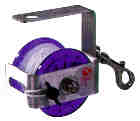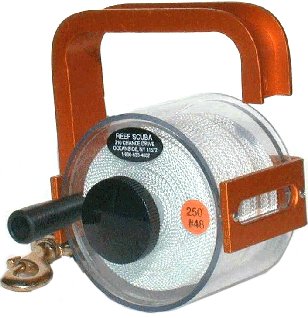Wreck Reel

A wreck reel should be considered standard equipment on all but the easiest open ocean dives. Even if you aren't into wreck penetration, you can use the reel as a foolproof way of always knowing how to get home. Just clip it on, and off you go. This is much easier and more reliable than any other means of navigation, and is useful in many situations, especially in poor visibility. Among other things, a wreck reel will allow you to make explorations over featureless sand areas, and in confusing debris fields, like the Mohawk, as well as conduct organized searches, etc. In open water, a wreck reel is often more useful than a compass, although you should always carry one of those as well. On the other hand, there is no real use for a wreck reel in a typical inlet or jetty dive, whereas your compass will be extremely useful.

When using a wreck reel, don't just clip the line to the boat anchor - anchors have been known to pull out, and if the line breaks when that happens, you're lost. The line should be attached to a fixed object on the bottom near the anchor, and then a second tie made not more than 5-10 ft away from the first, in the direction of travel. Line entanglements can be avoided by "placements" from time to time, which can be single turns around an object, with the line pulled tight beforehand so it doesn't come undone. This is especially important when changing direction. The last thing you want to do is let the line go slack; that's when it's most likely to tangle up. Because of this possibility, you should not use a wreck reel unless you have a good sharp dive knife as well.
Besides navigation, wreck reels have many other uses. A wreck reel can be used as an emergency up-line. This is a means to avoid having to do an emergency free ascent and safety stop, which is highly undesirable in the open ocean with a current. The obvious way to do this is to simply tie the line to some fixed object on the bottom, but this necessitates cutting the line at the surface and losing it. A better way is to find an object with a hole or eye in it. Thread the line through the eye, so that it slides freely, and then clip it back onto the reel. As you ascend, the line will form an ever-lengthening loop between you and the bottom, up to half the total length of your line. You can now do your safety stop easily with no fear of drifting off.
When the time comes to get free of the bottom, cut the line right at the snap so that the end has no knot or loop that might snag, and just reel it in. You can reattach the snap later, and you will only lose a few inches of line. Adding a lift bag to the top of the loop will mark your position for the boat to find you, and also make your "hang" a little easier. An important point when using this method is that you should clip the reel to yourself rather than just hand-holding it - dropping the reel at this point would be disastrous!
When your decompression or safety stop is complete, let out some more line until you break the surface and can ascertain your situation. Signal the boat, and make a judgment as to whether or not you can make the swim with the prevailing current. Unless it looks easy, sit tight and don't cut the line, it's the only thing that keeps you from drifting away! Nine out of ten of the monthly DCS horror stories you can find in the scuba magazines could be avoided by practicing and using simple self-rescue techniques like this, and hanging a few extra minutes at the end of every dive.
You can also use a wreck reel to recover objects from the bottom. Just tie it on, and do a normal ascent and safety stop, paying out the line behind you. Once in the boat, simply pull the object up. You won't raise any anchors this way, but 1/8" line is certainly sufficient to lift a weight belt or overloaded goody bag, and a lot easier and safer than overinflating your BC to hand-carry an object to the surface.

The most common sizes for wreck reels are 90 ft ( 3" spool, pictured, ) 250 ft ( 5" spool ) and 400 ft ( 7" spool. ) All are useful, but the larger ones allow for longer excursions and also reel in faster. Usually, two weights of nylon line are available: #24 ( light ) and #36 ( heavy. ) I prefer the heavier line, as it is stronger and a little easier to manage, although you can carry less of it. Enclosed wreck reels are less likely to tangle up, but more difficult to fix when they do ( nearly impossible in the water, to tell the truth. ) I have two wreck reels, both Dive Rites. The small one quickly proved to be too small, so I got a bigger enclosed one. I think some of the locally made reels from Manta, Reef Scuba, and AquaExplorers are probably better for our conditions than the Dive Rite models, which are made for caving. But the Dive Rite certainly gets the job done, until I break it or lose it.
Thanks to diver Art Greenberg for pointing out the original deficiencies in this page and contributing corrections.
DIR
Reels are much as recommended here, except that a number of smaller-sized reels are recommended which are fairly useless in open water. Line-marker arrows and other such things are impractical outside of a cave.
